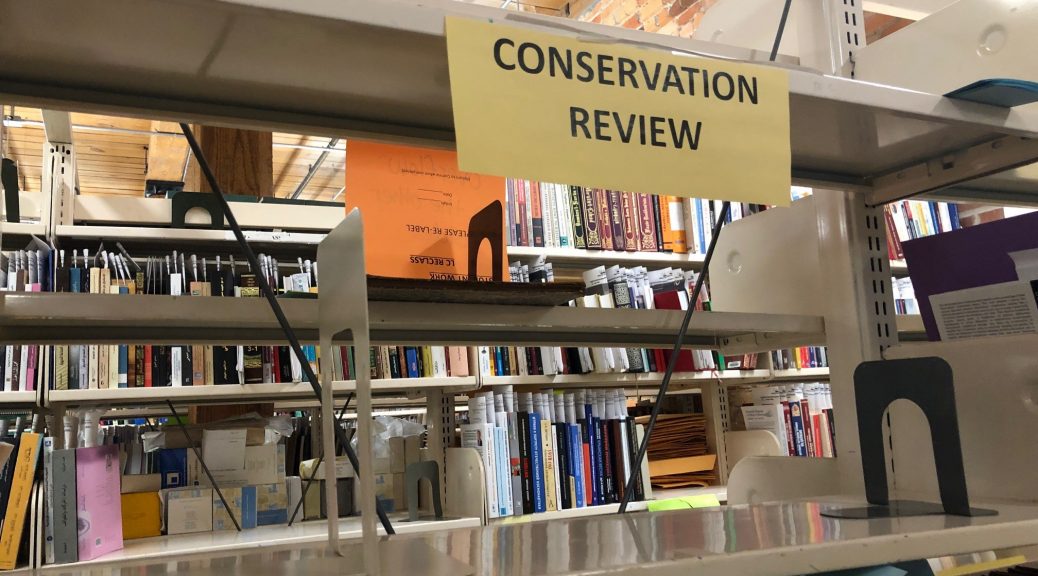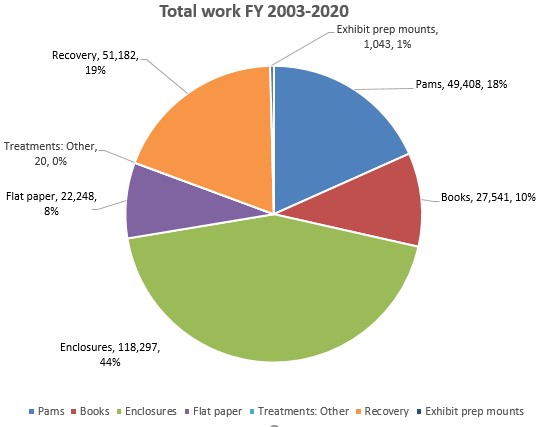It’s annual statistics time! We love a good stat.
One Stat That Stands Out
42% of overall productivity in FY2022 was disaster recovery, mostly attributed to mold removal.
FY 2022 Statistics
371 Book repairs
964 Pamphlet bindings
16 Treatments: Other (objects, textiles, etc.)
694 Flat Paper repairs (includes paper, parchment, and photos)
3,094 Protective enclosures
3,784 Disaster recovery
3 Exhibit mounts [these are primarily done in the Exhibits Department now]
44 Hours in support of Exhibits (meetings, treatment, installation, etc.)
123 Digital preparation repairs
8 Hours in support of Digital Projects (meetings, consultations, handling, etc.)
73% of production was for Special Collections
27% of production was for Circulating Collections
42.7% of work was Level 1 [less than 15 minutes to complete; 3,810 items]
54.5% of work was Level 2 [15 minutes – 2 hours to complete; 4,864 items]
2.7% of work was Level 3 [2 – 5 hours to complete; 240 items]
0.1% of work was Level 4 [more than 5 hours; 12 items]
Staffing: 5 full time conservation staff, 1 student assistant

We are still seeing the effects of the pandemic on our total production. But we are also seeing a bounce back from the last two years. We remain hopeful that FY2023 will be closer to “normal,” whatever that is these days.
| Totals | FY19 | FY20 | FY21 | FY22 |
| Level 1 | 9556 | 5422 | 1841 | 3810 |
| Level 2 | 15725 | 1522 | 972 | 4864 |
| Level 3 | 246 | 146 | 94 | 240 |
| Level 4 | 19 | 31 | 10 | 12 |
| total | 25546 | 7121 | 2917 | 8926 |
Total Productivity 2003 to 2022
This year we surpassed the 280,800 mark for total production since the department began in 2002. Overall, enclosures are still the largest single type of work we do, holding steady at 44% of output. Followed by disaster recovery at 20%, and pamphlet binding at 18%.

Other Things We Did This Year
- We received a LYRASIS Catalyst Fund grant to digitize our legacy conservation treatment documentation. We are calling it the Conservation Documentation Archive (CDA). This includes both written and photographic documentation, reaching back to the earliest treatment records we have. You will be hearing much more about that in the coming year as we get these materials into our digital repository.
- We had several internal conversations about the lack of diversity in our treatment terminology. We aim to be more cognizant of this going forward. We want to fill in the gaps in our knowledge of book history so that we can be more inclusive in describing the materials we work on.
- We took a deeper dive into issues of diversity, equity, and inclusion within the conservation profession and our department this year through readings and discussions. These will be ongoing conversations. We are focusing on ideas that can be put into action now, while also identifying stretch goals that may take more time and resources than what we have at the moment.
- The Lilly Library renovation is back on track. We are in the middle of preparing the collections, and the art and artifacts for the move. Much more to come on this project.







